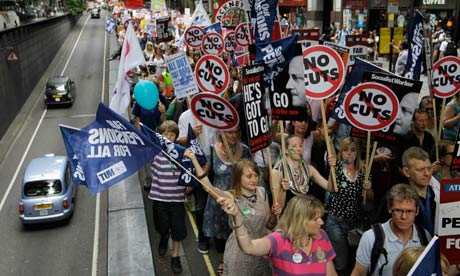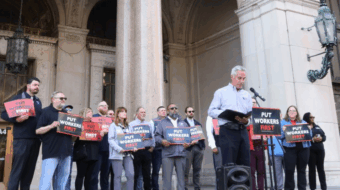
NEW HAVEN, Conn. – Imagine, three years ago, that you’re a custodian in the New Haven, Conn., schools, and the school board decides to privatize your job, by contracting it out, to GCA Services Group, to “save money.” What do you think would happen to you?
What actually happened, according to a new report on such privatization schemes, was this: Two-thirds of 186 custodians were fired and replaced by part-timers. All the custodians saw their pay cut by 40 percent, to $12.50 an hour. The part-timers lost health insurance, overtime pay, bonuses and retirement benefits. Dozens went on food stamps and Medicaid.
Their situation was so bad that the custodians, previously non-union, turned to Service Employees Local 32BJ, the big union’s top sector for those workers. They won an organizing drive and the school district negotiated a new contract with SEIU 32BJ. The 162 part-timers got a $1.20 an hour raise, plus some health benefits, sick pay and vacation pay.
But they’re still part-timers, and their compensation is still far from the level that New Haven school custodians enjoyed before the privatization hit.
Unfortunately, the New Haven story is not unique, says the report, Race To The Bottom: How Outsourcing Public Services Rewards Corporations And Punishes The Middle Class, which the Communications Workers helped commission and pay for.
Instead, it’s rife all over the nation, from schools to hospitals to prisons. And impacts of privatization – lower wages, no benefits and no protection on the job for workers, and forcing the workers to use public benefits – ripple throughout local economies, the report adds.
The report, by the think tank In The Public Interest, “is important research that connects how privatization has far-reaching, negative effects in the community well beyond the contract itself,” said Brooks Sunkett, vice president of CWA’s Public, Health Care and Education Workers sector. The report closes with a list of recommendations for improvements.
The report is notable because 35 percent of the nation’s public workers are unionized, and those workers have become top targets of Right Wing anti-union anti-worker demagogues and forces. They view privatization as one way to destroy unions and thus defuse or silence opposition to their pro-plutocratic agenda.
It’s also notable because the report shows how privatization hurts not just the workers involved, but their communities and economies. Its findings include:
- “Outsourcing public services sets off a downward spiral in which reduced worker wages and benefits can hurt the local economy and overall stability of middle and working class communities. By paying family-supporting wages and providing important benefits such as health insurance and sick leave, governments historically created intentional “ladders of opportunity” to allow workers and their families to reach the middle class. This is especially true for women and African Americans for whom the public sector has been a source of stable middle-class careers. Low-road government contracts reverse this dynamic.
About 52 percent of state workers are women, as are 62 percent of local government workers and one-fifth of all African-American workers.
- University of Colorado Professor Daphne Greenwood found the ripple effect in the local economy. She reported “in a medium-sized American city, dollars spent in the local economy fall from 49 percent of total payroll to 9.5 percent,” after privatization. That latter figure declines when workers live elsewhere, she noted – a frequent phenomenon when pay cuts force public workers to move out of the town that employs them.
“Lower spending in the local economy can have a range of significant negative impacts on tax revenues, the housing market, and local businesses,” she reported. “When it comes down to it, poverty is not cheap,” Greenwood told the report’s authors.
- Taxpayers wind up subsidizing the private contractors, but the costs are hidden. That’s because the now-low-paid workers must turn to public assistance – food stamps, Medicaid or the emergency room due to no health insurance, housing vouchers and the earned income tax credit – to make ends meet, since their pay won’t do it.
“This spending amounts to a hidden cost to the government not factored into the cost analysis when deciding whether to outsource a particular public service. By slashing labor costs, a company may be able to show cost savings on paper. However, low wages often mean the number on public assistance increases and income and healthcare costs, instead of being the contracting employer’s responsibility, are merely shifted onto other parts of the government budget,” the report notes.
“These hidden costs of low-wage work amount to an implicit public subsidy to for-profit corporations. For example, researchers found school cafeteria workers working for contractors in California received an average of $1,743 annually in public assistance because of low pay. These hidden costs are rarely, if ever,” considered in outsourcing decisions.
The report had several recommendations to solve the problem of public jobs being converted into low-income no-benefit contracted-out jobs. They included:
- Governments should ensure cost savings that contractors promise come from better efficiency, not wage and benefit cuts. “By requiring cost savings to come from innovation and efficiencies, instead of from the pockets of lower-income workers, states and localities can send a clear message that only high-road firms will receive government contracts,” it says.
- “If a contractor is going to employ workers to perform public work using public dollars, those jobs should fulfill the goal of using public money to strengthen our economy and build the middle class. Workers should be paid a living wage and provided reasonable benefits, such as health insurance and sick leave by their contractor employer.
- “States and local governments should track how much money is spent on private contracts,” how many workers they employ and their wage rates and the information should be public, online.
- Governments should conduct a social and economic impact analysis before outsourcing and make it public before voting on the outsourcing. The analysis should include expected changes in staffing, wages and benefits, expected impacts on social services and public assistance programs, the racial and gender mix of affected workers – and how many would be retained or fired – and the expected impact on workers’ housing, local businesses and local tax revenue.
“This will ensure that policymakers and the public fully understand the ramifications of any outsourcing decisions before the contract is signed,” the report says.
“Raising worker standards is an important part of building a robust middle class and chipping away at income inequality. When workers can support themselves and their families, the whole community wins. There is more spending in the local economy, city and state tax revenues increase, and hidden costs on government budgets diminish,” it concludes.
Photo: Sang Tan/AP










